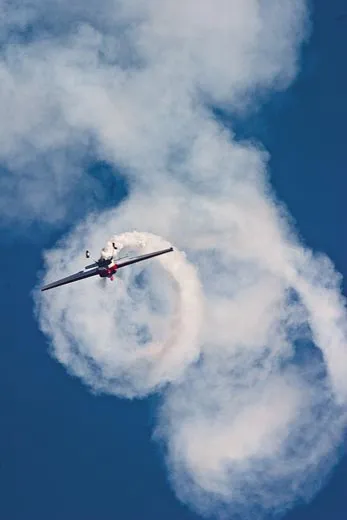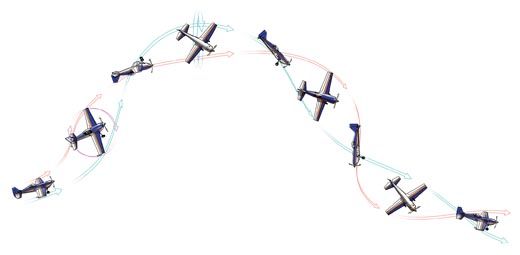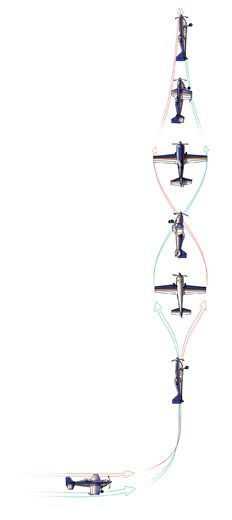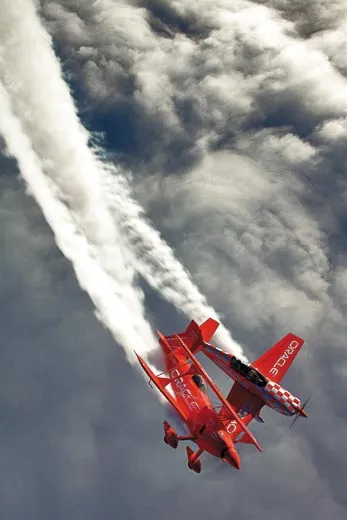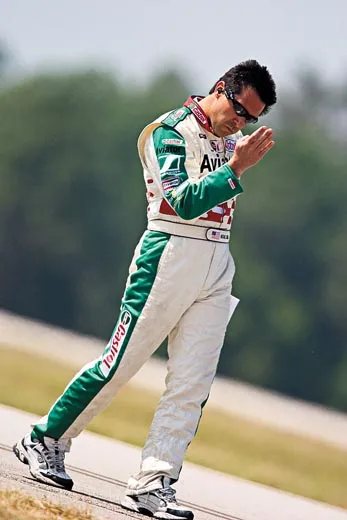Tumbling with the Stars
Today’s airshow performers do it gyroscopically.
/https://tf-cmsv2-smithsonianmag-media.s3.amazonaws.com/filer/Today_Stunt_Flash_JJ09.jpg)
When I started flying airshows, back in 1971, the edge of the known aerobatic world was a maneuver known as the lomcevak. The great-granddaddy of tumbles, the lomcevak (pronounced “LAHM-sha-vock”) took you to a wild place, where one minute the air under your wing was solid as a fist, and the next you were toppling tailwheel over nose cone into the abyss, as out of control as an unhinged car on a Ferris wheel.
Recently I watched aerobatic performer Greg Poe cartwheel his bright red Fagen MX-2 across the show line. A few beats later, the airplane began a tight, fast, vertical roll, which widened into a corkscrew and topped out around 2,000 feet. There it stayed, continuing to rotate, but now Frisbee-like, with its nose following the horizon. It hovered for a moment before flat spinning downward. Poe had seamlessly blended four maneuvers into a single magic trick. His routine is only one of a dozen on the airshow circuit today that make me realize: Tumbles have changed.
Nobody knows exactly how many kinds of tumbles there are now. If we could tally all the differences in the maneuvers that depend on aircraft design, center of gravity, entry and exit attitudes, control movements that change during the maneuvers, and the amount of experience and recent practice pilots have, the number would be overwhelming. Some show pilots have created—and named—signature tumbles. One of the most famous is Sean Tucker’s Centrifuge. Tucker’s Oracle Challenger Pitts leaps across the sky from tumble to tumble. Its nose twists over its right shoulder toward its tail 7, 8, 9 times—as if snarling at a demon behind it—10, 11, 12 times.
All the various tumbles have one thing in common: Pilots get into them by using the gyroscopic effect of a spinning propeller. Pushing on a spinning gyro moves it 90 degrees to the left or right of the direction the push came from. A pilot starts a roll, and, with the help of the propeller’s gyroscopic forces, skids the nose to point at an angle from the line of forward motion (see “Shoulder Roll,” opposite). The airplane behaves like a car going downhill fast, skidding sideways, then rolling over.
When the only game in town was the lomcevak, we entered the tumble in climbing roll, pushed the ailerons on our wings one way and the rudder on our tail the other way, then just hung on until the airplane spit us out into an inverted spin. The airplanes responded differently. For instance, my Pitts would tumble slightly cock-eyed, tail over wing, whereas Art Scholl’s Super Chipmunk would tumble forward, tail following nose as if the airplane were inside a squirrel cage. But we called them all lomcevaks—a Czech word for either a headache, a hangover, or a big slug of plum brandy; we’d heard all these translations.
We did them on purpose, of course, but three-time world aerobatic pilot Nikolay Timofeev says that Czech pilot Ladislav Bezak probably discovered the first one in his Zlin by accident, the way Soviet pilots discovered some of their tumbling maneuvers around 1976. “As soon as we receive Yak 50 we start to do negative snaps on vertical line,” he says (see “Vertical Roll,” left). “And we jump into gyroscopic inertia rotation because Yak 50 is not really good airplane for negative snaps, especially on vertical up lines. I believe same story in Czech Republic. Zlin 50 is also not excellent for negative snap on way up.”
Mistakes can be turned into maneuvers if pilots can figure out what they did in the first place. Former U.S. national aerobatic champion David Martin has perfected a forward tumble that is so straight and so tightly flown that it looks as if his CAP 232 is swinging by its tailwheel from a high wire. He has spent thousands of hours practicing aerobatics, particularly his tumbles.
“If you are talking something new that you want to do in an airshow,” he says, “you have to figure out how to do it; then you have to figure out how to consistently do it; then you’ve got to figure out doing it at a lower altitude. It takes a while. I practice purposely messing them up. Because if I am going to be doing them at low altitude, I need to know what is going to happen. So that is a lot of practice.”
The first time he did the one he calls the Good Tumble it was by accident, but luckily someone got it on video. “I looked at that video hundreds of times, trying to figure out exactly what I did,” he says. “It took a long time. At first, even after I figured out how to do it, I might get it 50 percent of the time, then it would be 75 percent, then finally I’ve got it now where it is. I won’t say it is 100 percent, but at least 90 percent of the time it will do what I want it to do.
“The thing I learned about tumbling maneuvers is that nobody is very good at telling you how to do it. You’ve got to kind of figure it out on your own.”
Debby Rihn-Harvey, the current national aerobatic champion, says that when airshow fans ask about tumbles, pilots are cautious about what they share, because tumbles are potentially dangerous. “Every airplane is going to be a little bit different,” she says.
Rihn-Harvey flies a CAP 232 she calls the Hurricane II. Her show routine includes about six types of tumbles that she flies with competition-style precision and a touch of Texas yeehaw. When she’s not flying shows, Rihn-Harvey is an airline pilot and has her own flight school: H&R Aviation, in La Porte, Texas; if a stranger walks up and says, “How do you do that?” she says, “Come see me.”
With all their difficulties and dangers, tumbles progressed slowly at first. In 1983, French pilot Claude Roux discovered a forward somersault he called the ruade. Two years later, Ray Williams added a flourish to the hammerhead—an airshow staple in which the pilot zooms vertically until he’s almost out of airspeed, then kicks the airplane into a cartwheel. When Williams realized his Pitts S-2S could be coaxed into doing not just one but two pivots at the top of the hammerhead, he christened the new maneuver “whifferdill.” In 1988, world aerobatic champion Henry Haigh brought us the knife-edge spin (see illustration, p. 45).
Other people were experimenting too, but the main reason gyroscopic maneuvers developed slowly and sporadically was that they broke airplanes. Their snapping entries produced sudden, jolting side loads on the airframe, the engine mounts, the tail sections, and especially the engine crankshafts. The metal propeller blades actually helped tumble the airplanes, but their weight also strained crankshafts and broke more than a few.
These dangers made most of us limit ourselves to one lomcevak per airshow; however, nothing slowed down future superstars Sean Tucker and Wayne Handley. On his way to discovering new ways to tumble airplanes, Tucker lost a propeller and broke nine crankshafts.
From 1984 through 1986, while both made a living as cropdusters, Tucker and Handley pursued their passion for tumbling maneuvers: practicing, critiquing, and egging each other on to try new things. “Wayne is an incredible innovator and thinker, a student of it,” Tucker says. “But I clearly hold the record for broken crankshafts.”
Airshow legend Gene Soucy recalls seeing the two fly for the first time, at Salinas, California. “I just stood there with my mouth open,” he says. “They were flying the little Pitts, just like I had flown for 15 years, and were doing things I had never imagined. Here I was three-time national champion and my buddies were world team members. Even Leo [Loudenslager] was flying his ultimate airplane, and all we ever did was that one lomcevak. But all of a sudden you see these guys doing it on vertical lines, and doing the shoulder roll, like Sean’s Centrifuge, eight different ways, eight different new maneuvers in that one show I watched that day. I just didn’t believe it. Wayne Handley and Sean created that whole thing.”
Tucker and Handley could not have maintained this quest had builders and manufacturers not significantly changed the designs of propellers, engines, and airframes. A lightweight, composite, three-blade propeller and a solid crankshaft flange ended Tucker’s train of crankshaft mishaps.
Around the early 1990s, many aerobatic performers shifted from biplanes to monoplanes, and that migration set off another radical change. When aggressive flying led to cracks in wooden wings, the solution was to make wings of composites—carbon fiber layers over lightweight, honeycomb cores. “Once they switched to the composite material, assuming the wing is laid up properly, they were just almost indestructible wings,” Greg Poe says. “And so then, once you get to that point, then you become comfortable and it is now a matter of your imagination, how you can tweak a maneuver, how you present it to the crowd. Now the airplane is no longer the weak link.”
With airplanes they could trust, pilots flew as hard as they wanted, and creativity blossomed. Three-time national aerobatic champion Patty Wagstaff, who flies a Cirrus-sponsored Extra 300S, points out that the inspiration for some of the new maneuvers came from unusual sources. “The knife-edge spin was a really interesting maneuver that came from the [radio control] modelers,” she says, “and Henry Haigh started doing it in competitions.”
Some aerobatic pilots found ways to manipulate their airplanes to mimic the true tumble, to fly them all the way through the gyroscopically assisted maneuver so they are in control, rather than just along for the ride. In his routine, Michael Goulian, the 1995 national aerobatic champ, does nine tumbles that are like perfectly choreographed dance steps, timed to a music soundtrack. “When I do a tumble,” he says, “the attitude and the direction of exit is absolutely predetermined every single time. In other words, I am doing the same tumble, with the same entry and the same exit, every time. It is a matter of spending hours and hours of learning how to do them.
“In a tumble you are always evaluating the attitude with which the plane is tumbling. Has it translated 90 degrees? How much energy is in the tumble? Am I going to do three rotations or four? In a tumble, you are thinking it through. You are not along for the ride. I will actually modulate the throttle and the rudder and the ailerons to fix a tumble that has gone bad…or to make it better, to make it flip one more time.”
I’ve watched him at shows: He pitches his Extra 300SHP forward at the top of a loop, yaws it sideways, and shows us the airplane tumbling from left to right while its nose peeks sideways at us. Then when it looks as if the airplane will rotate one more time, he stops mid-tumble, just because
he can.
Sean Tucker also taught himself to control the aircraft from the start of the tumble to the finish. “What I really focused on was how to fly the machine so I could do 9, 10, 11, 12 of them in a row across the sky,” he says. “It is not that difficult to do one of them, but to sustain one more than four or five times really takes finesse. It takes touch.”
Although they look wild, tumbles are not necessarily violent. “They have grown more aggressive and the perception is that they are out of control,” Tucker says. “Planes aren’t falling out of the sky and wings aren’t breaking off anymore, so they can’t be more violent. They are more dynamic, and that leads to the perception that they are more extreme. A nose-over-tail tumble is a zero-G maneuver. It is not violent. A centrifuge at high speeds will hurt you, though. It is 7 to 8 negative Gs. And a Bill Stein knife-edge spin is a lot of Gs.”
The best tumbling pilots practice relentlessly. “If you don’t practice them hundreds and hundreds of times,” Tucker says, “they will kill you at airshow altitudes. It all depends on what your altitude is. You always have to have your margins.”
It is not just the tumble a pilot has to prepare for, but also the spin that naturally follows a tumble. Japanese airshow pilot Rock Iwasaki was killed during a practice in 2005 while spinning out of a low-altitude tumble.
Tucker says, “I know that at 1,000 feet I can get out of an inverted flat spin, pull down and miss the ground, and still have energy. So any gyroscopic maneuver that I do, that I know has the potential to go into an inverted flat spin, always tops out at 1,000 feet above the ground, never at 800, even though you can do it all the time.”
At any altitude, performers flying tumbles thrill airshow crowds. Whenever I watch their routines, I remember a sticker Patty Wagstaff once had on the back of her Extra. “We’re professionals,” it said. “Don’t try this at home.”
